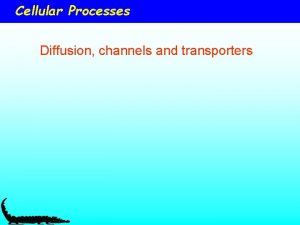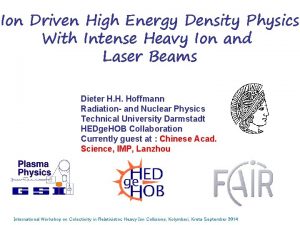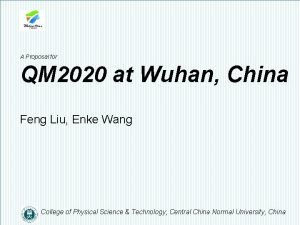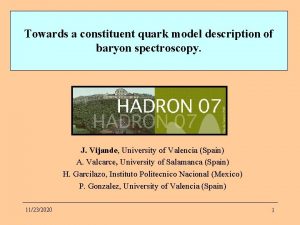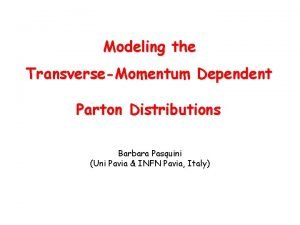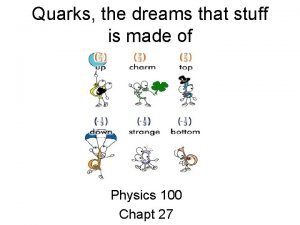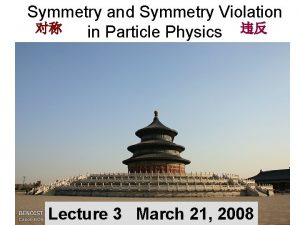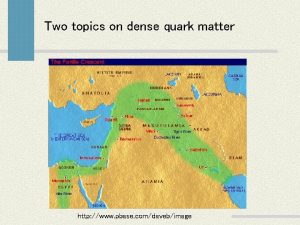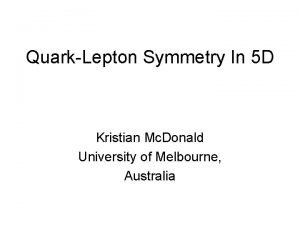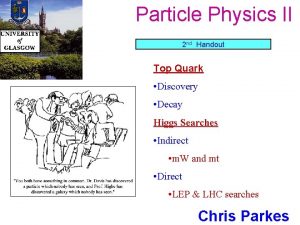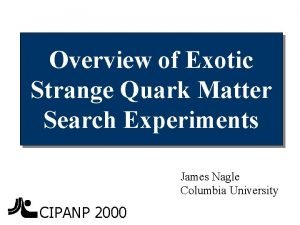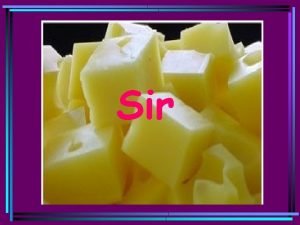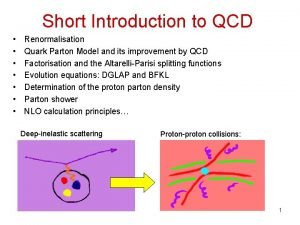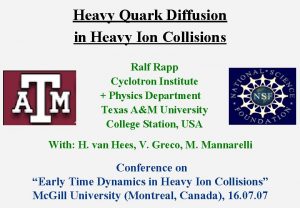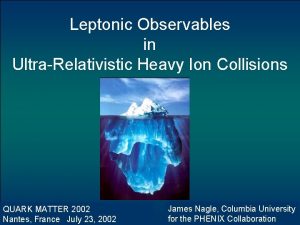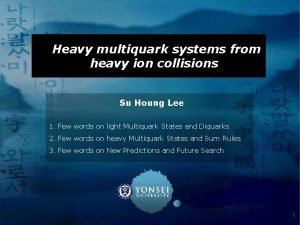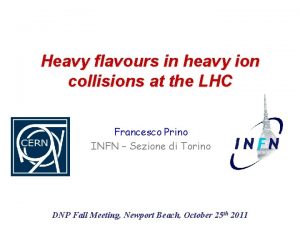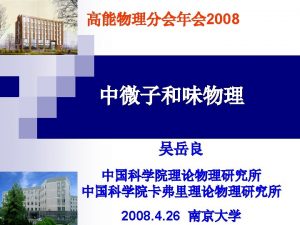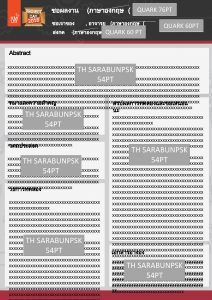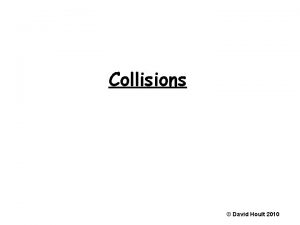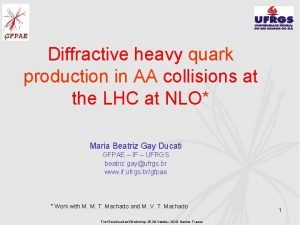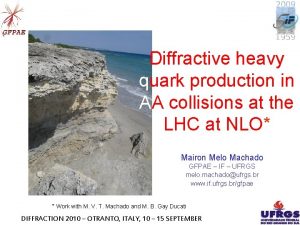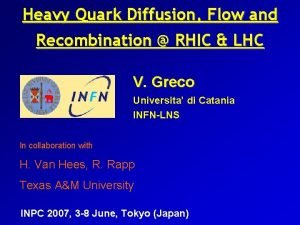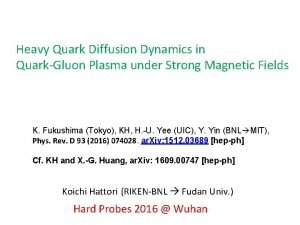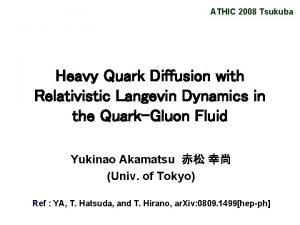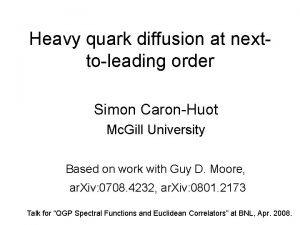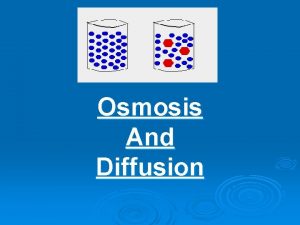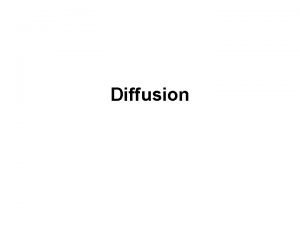Heavy Quark Diffusion in Heavy Ion Collisions Ralf







![2. 3 Heavy-Quark Spectra at RHIC [van Hees, Greco+RR ’ 05] Relativistic Langevin Simulation: 2. 3 Heavy-Quark Spectra at RHIC [van Hees, Greco+RR ’ 05] Relativistic Langevin Simulation:](https://slidetodoc.com/presentation_image_h/275acc8e720c9e5ee2b1cbec7a214d3b/image-8.jpg)




![2. 5 Model Comparisons to Recent PHENIX Data Single-e± Spectra [PHENIX ’ 06] • 2. 5 Model Comparisons to Recent PHENIX Data Single-e± Spectra [PHENIX ’ 06] •](https://slidetodoc.com/presentation_image_h/275acc8e720c9e5ee2b1cbec7a214d3b/image-13.jpg)






![3. 2 Selfconsistent T-Matrix and Selfenergy [Mannarelli+RR ’ 05] - T-Matrices q-q T=1. 2 3. 2 Selfconsistent T-Matrix and Selfenergy [Mannarelli+RR ’ 05] - T-Matrices q-q T=1. 2](https://slidetodoc.com/presentation_image_h/275acc8e720c9e5ee2b1cbec7a214d3b/image-20.jpg)
![5. 3. 2 Dileptons II: RHIC [R. Averbeck, PHENIX] [RR ’ 01] QG P 5. 3. 2 Dileptons II: RHIC [R. Averbeck, PHENIX] [RR ’ 01] QG P](https://slidetodoc.com/presentation_image_h/275acc8e720c9e5ee2b1cbec7a214d3b/image-21.jpg)
- Slides: 21

Heavy Quark Diffusion in Heavy Ion Collisions Ralf Rapp Cyclotron Institute + Physics Department Texas A&M University College Station, USA With: H. van Hees, V. Greco, M. Mannarelli Conference on “Early Time Dynamics in Heavy Ion Collisions” Mc. Gill University (Montreal, Canada), 16. 07

1. ) Introduction: Heavy Quarks at RHIC • c, b quarks (more!? ) sensitive to: Diffusion/interactions - thermalization (low p. T) in s. QGP at all p. T - energy loss (high p. T) Hadronization (low p. T? ) - coalescence (int. p. T? ) Direct relation to other observables • quarkonia: - interaction with c, b within bound state - regeneration →Y • intermediate-mass dileptons: → e+e- X competes with thermal (QGP) radiation [PHENIX ’ 07]

Outline 1. ) Introduction Single-Electron Puzzle at RHIC 2. ) Heavy-Quark Diffusion in (s)QGP Fokker-Planck Approach Resonance Model HQ and e± Spectra at RHIC 3. ) Lattice-QCD Based Potential Approach In-Medium Heavy-Light Quark T-Matrix Transport Coefficients HQ RAA and v 2 4. ) Conclusions

1. 2 Expectations at RHIC c, b • Radiative energy loss smaller for c+b quarks • Elastic interactions? • Collective flow? Heavy-quark diffusion? • experimental tool: electron spectra D, B → e. X RAA = (AA) / (pp) Nuclear Modification Factor Elliptic Flow [Gyulassy etal ’ 05] ? [Armesto et al ’ 05] p. T [Ge. V] • factor 4 -5 suppression • elastic E-loss, p. QCD? ! • substantial collectivity • bottom “contamination”?

2. ) Heavy-Quark Diffusion in the QGP Q • Brownian Motion: scattering rate Fokker Planck Eq. [Svetitsky ’ 88, …] diffusion constant Microscopic Calculations of Diffusion: [Svetitsky ’ 88, Mustafa et al ’ 98, Molnar et al ’ 04, Zhang et al ’ 04, Hees+RR ’ 04, Teaney+Moore‘ 04] 2. 1. 1 Perturbative QCD g q c c dominated by t-channel gluon-ex. : • e. g. T =300 Me. V, as=0. 4: ttherm~15 fm/c slow! (t. QGP ≤ 5 fm/c)

2. 1. 2 Open-Charm Resonances in QGP _ q c _ “D” q c “Light”-Quark Resonances [van Hees+ RR ’ 04] • effective lagrangian with pseudo/scalar + axial/vector “D-mesons” • parameters: m. D=2 Ge. V , GD , mc=1. 5 Ge. V, mq=0 • chiral (u, d) + HQ (c, b) symmetry • resonance cross section isotropic, p. QCD forward 1. 4 Tc [Asakawa+ Hatsuda ’ 03]

2. 1. 3 Thermal Relaxation of Heavy Quarks in QGP Charm: p. QCD vs. Resonances Charm vs. Bottom p. QCD “D” • factor ~3 faster with resonance interactions! • tctherm ≈ t. QGP ≈ 3 -5 fm/c • bottom does not thermalize
![2 3 HeavyQuark Spectra at RHIC van Hees GrecoRR 05 Relativistic Langevin Simulation 2. 3 Heavy-Quark Spectra at RHIC [van Hees, Greco+RR ’ 05] Relativistic Langevin Simulation:](https://slidetodoc.com/presentation_image_h/275acc8e720c9e5ee2b1cbec7a214d3b/image-8.jpg)
2. 3 Heavy-Quark Spectra at RHIC [van Hees, Greco+RR ’ 05] Relativistic Langevin Simulation: • stochastic implementation of HQ motion in expanding QGP-fireball • “hydrodynamic” evolution of bulk-matter b. T , v 2 Nuclear Modification Factor Elliptic Flow • resonances → large charm suppression+collectivity, not for bottom • v 2 “leveling off ” characteristic for transition thermal → kinetic

2. 3. 2 The first 5 fm/c for Quark-v 2 and -RAA Inclusive v 2 • RAA built up earlier than v 2

2. 3. 3 HQ Langevin Simulations: Hydro vs. Fireball Elastic p. QCD (charm) + Hydrodynamics a , g [Moore+Teaney ’ 04] s 1 , 3. 5 0. 5 , 2. 5 0. 25, 1. 8 • Tc=165 Me. V, t ≈ 9 fm/c • sg. Q ~ (as/m. D)2 as and m. D~g. T independent (m. D≡ 1. 5 T) • as=0. 4, m. D=2. 2 T ↔ D(2 p. T) ≈ 20 hydro ≈ fireball expansion [van Hees, Greco+RR ’ 05]

2. 4 Single-e± at RHIC: Effect of Resonances • hadronize output from Langevin HQs (d-fct. fragmentation, coalescence) • semileptonic decays: D, B → e+n+X Fragmentation only • large suppression from resonances, elliptic flow underpredicted (? ) • bottom sets in at p. T~2. 5 Ge. V

2. 4. 2 Single-e± at RHIC: Resonances + Q-q Coalescence fq from p, K [Greco et al ’ 03] Nuclear Modification Factor Elliptic Flow • less suppression and more v 2 • anti-correlation RAA ↔ v 2 from coalescence (both up) • radiative E-loss at high p. T? !
![2 5 Model Comparisons to Recent PHENIX Data Singlee Spectra PHENIX 06 2. 5 Model Comparisons to Recent PHENIX Data Single-e± Spectra [PHENIX ’ 06] •](https://slidetodoc.com/presentation_image_h/275acc8e720c9e5ee2b1cbec7a214d3b/image-13.jpg)
2. 5 Model Comparisons to Recent PHENIX Data Single-e± Spectra [PHENIX ’ 06] • p. QCD radiative E-loss with 10 -fold upscaled transport coeff. • Langevin with elastic p. QCD + resonances + coalescence • Langevin with 2 -6 upscaled p. QCD elastic • coalescence essential for consistent RAA and v 2 • other mechanisms: 3 -body collisions, … [Liu+Ko’ 06, Adil+Vitev ‘ 06]

2. 5. 2 Transport Properties of (s)QGP Spatial Diffusion Coefficient ‹x 2›-‹x› 2=Dx·t, Dx=2 d·(T/m. Q)/g, Ds=Dx/2 d Charm-Quark Diffusion Viscosity-to-Entropy: Lattice QCD [Nakamura +Sakai ’ 04] • small spatial diffusion → strong coupling E. g. strongly coupled gauge theory (Ad. S/CFT): h/s=1/4 p, DHQ≈1/2 p. T resonances: DHQ≈4 -6/2 p. T , DHQ ~ h/s ≈ (1 -1. 5)/p

3. ) _ Potential Scattering in s. QGP Lattice Q-Q Free Energy Applications • → Schrödinger-Eq. → bound states (s. QGP) [Shuryak+ Zahed ’ 04, …] • scattering states + imaginary parts [Bielefeld Group ’ 04] → Lippmann-Schwinger Eq. [Mannarelli+RR ’ 05] Q-q- T-Matrix solve numerically

3. 2 Charm-Light Cross Sections with l. QCD-based Potential Temperature Evolution • interaction strength close to threshold 2 Channel Decomposition • meson and diquark channels dominant

3. 3 Friction Coefficients (Relaxation Rate): Lat-QCD vs. Resonance Model T ≈ 200 Me. V T ≈ 250 Me. V • uncertainty in potential extraction from lattice QCD • potential scattering comparable to resonance model close to Tc

3. 4 Charm-Quark Spectra at RHIC Nuclear Suppression Factor Elliptic Flow • supports importance of nonperturbative effects • radiative (2↔ 3) scattering?

4. ) Summary and Conclusions • Heavy quarks probe the (s)QGP: strong suppression, collectivity • Importance of elastic collisions • Indications for nonperturbative interactions • Supported by microscopic description: l. QCD-based T-matrix, scrutinize: l. QCD correlators, U 1 vs. F 1, finite-T quark masses • “Hadronic” correlations dominant (meson + diquark) ↔ natural connection to quark-coalescence at Tc [Ravagli+RR ’ 07] • Impact on other observables: light sector, quarkonia, dileptons, …
![3 2 Selfconsistent TMatrix and Selfenergy MannarelliRR 05 TMatrices qq T1 2 3. 2 Selfconsistent T-Matrix and Selfenergy [Mannarelli+RR ’ 05] - T-Matrices q-q T=1. 2](https://slidetodoc.com/presentation_image_h/275acc8e720c9e5ee2b1cbec7a214d3b/image-20.jpg)
3. 2 Selfconsistent T-Matrix and Selfenergy [Mannarelli+RR ’ 05] - T-Matrices q-q T=1. 2 Tc T=1. 5 Tc T=1. 75 Tc Quark Self. Energy T=1. 5 Tc • assume mq(gluon)=0. 1 Ge. V • transition from bound (1. 2 Tc) to resonance states! • quark-width ≈0. 3 Ge. V≈(2/3 fm)-1 (≈ mass ↔ liquid!? ) • colored states, equat. of state?
![5 3 2 Dileptons II RHIC R Averbeck PHENIX RR 01 QG P 5. 3. 2 Dileptons II: RHIC [R. Averbeck, PHENIX] [RR ’ 01] QG P](https://slidetodoc.com/presentation_image_h/275acc8e720c9e5ee2b1cbec7a214d3b/image-21.jpg)
5. 3. 2 Dileptons II: RHIC [R. Averbeck, PHENIX] [RR ’ 01] QG P • low mass: thermal! (mostly in-medium r) • connection to Chiral Restoration: a 1 (1260)→ pg , 3 p • int. mass: QGP (resonances? ) vs. cc- → e+e-X (softening? )
 Contagious diffusion diagram
Contagious diffusion diagram Swabt
Swabt Facilitated diffusion ion channels
Facilitated diffusion ion channels Fuerzas dipolo-dipolo ejemplos
Fuerzas dipolo-dipolo ejemplos Intermolecular forces on vapor pressure
Intermolecular forces on vapor pressure Ejemplo de fuerza ion ion
Ejemplo de fuerza ion ion Qumica
Qumica Heavy ion
Heavy ion Ratey rational functions
Ratey rational functions Quark matter 2022
Quark matter 2022 Constituent quark model
Constituent quark model Quark model
Quark model 6 types of quarks
6 types of quarks Quark gluon plasma
Quark gluon plasma Physics wordle
Physics wordle A charm quark has a charge of approximately
A charm quark has a charge of approximately Quark gluon
Quark gluon Quark lepton symmetry
Quark lepton symmetry Top quark decay
Top quark decay Color quarks
Color quarks Zamjena za kačkavalj sir
Zamjena za kačkavalj sir Quark parton model
Quark parton model


